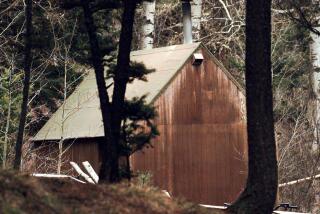Logging, Mining Issues in Montana Raise Concerns About Kaczynski
- Share via
LINCOLN, Mont. — Shortly after the Unabomber struck the office of the California Forestry Assn. a year ago, Cary Hegreberg got a call from the FBI: Be suspicious, he was told. If you come home from work and there’s a package left by the door, don’t touch it. Don’t let the children get the mail.
Hegreberg, who runs the forestry trade group’s Montana counterpart, the Montana Wood Products Assn., was told he could be next on the Unabomber’s lethal roster of representatives of the industrial and technological age. For the past 12 months, it has been a nagging worry he hasn’t been able to shake.
Now Hegreberg knows the danger may have been closer than he thought. The suspect arrested this week in connection with the bombing investigation, former mathematics professor Theodore J. Kaczynski, lived in Lincoln, only 60 miles away from Hegreberg’s home in Helena, Mont. On occasional trips to Helena, Kaczynski stayed at a hotel just two miles from Hegreberg’s office.
“I can’t even explain how I felt when he was arrested,” Hegreberg said Friday. “I picked up the newspaper and read the suspected Unabomber had been picked up literally in my backyard. It just sent chills down my spine.”
Lincoln is a remote town of 1,500 people, more than an hour’s drive up into the Rocky Mountains, but in it Kaczynski would have found a brutal collision between nature and technology of precisely the kind the Unabomber dreaded most.
On the banks of the Blackfoot River, whose shimmering flow through rocks and spruce past Lincoln is one of Montana’s great natural wonders, there is a plan to construct the largest cyanide heap leach gold mine ever dug in North America.
The Phelps Dodge Mining Co., with a joint-venture partner, has launched formal environmental impact studies for a project that opponents fears could poison the Blackfoot with outflows of toxic arsenic and cyanide. The proposed huge gold pit, nearly a mile wide by 1 1/2 miles long and 600 feet deep, would mean digging 980 tons of rock out of a mountain next to the Blackfoot and Landers Fork.
The soil would be washed in 172 million pounds of sodium cyanide over about 15 years.
Company officials have taken great pains to ensure that no toxic runoff would flow back into the river, and a majority of Lincoln’s residents are enthusiastic about the 600 jobs the project would generate, along with $2.3 billion worth of gold.
But a cadre of environmental groups fear that the project could be the downfall of Lincoln, and the Blackfoot, already damaged by past mining upstream.
“We wondered right away whether Kaczynski was involved in any of the meetings, but his name didn’t show up,” said James Jensen of the Montana Environmental Information Center in Helena. “This is definitely destructive technology, and he [the Unabomber] has a sort of anti-technology view of the world. Was he worried about it? We don’t know.”
Maureen Fisher, editor of the Lincoln newspaper, the Blackfoot Valley Dispatch, said she never encountered Kaczynski at any protest meetings, but she wonders now about how he saw his own community developing around him.
“It’s very possible that he would be very disturbed about the mine,” Fisher said. “Now I’m thinking, if they found casings and partial bombs still in [Kaczynski’s cabin], what were they intended for? Was it maybe to stop any further destruction of his backyard? There’s that possibility.”
Controversies over logging in old-growth forests have touched western Montana with increasing vehemence in the past year. North of Lincoln, in the Kootenai National Forest, civil disobedience actions are planned over salvage logging sales of 60 million board feet of old-growth timber, including a 1,000-acre clear-cut, in prime grizzly bear habitat.
The issue of Kaczynski’s potential involvement in environmental opposition to logging emerged this week with unconfirmed reports that the bombing suspect had been seen at an Earth First! timber protest rally in Montana in November. Earth First! spokesmen said the group had not organized the Montana rally and had no knowledge of Kaczynski.
There was an International Temperate Forest Conference at the University of Montana, Missoula, in November 1994 organized by the Native Forest Network.
About 500 people attended the event, which group spokesman Tom Fullum said “focused on the way corporations do business in the forests around the world, and the way they tend to have control over them.”
“He could easily have been there,” said Fullum, who said the organization knew only about 200 of the 500 people who were present.
The environmental community has been troubled in recent days by any attempt to link its causes to those of the Unabomber.
“Some of us in the environmental community agree with some of the things he wrote about, the problems he saw in humans adapting to the level of technology we live in. But I don’t think any of us can relate to his tactics at all,” said Phil Nanas, spokesman for the Native Forest Council in Eugene, Ore., which has organized several timber protests in the past year.
In Great Falls, Mont., one of two destinations for the two buses a day that run out of Lincoln, the Montana State University College of Technology lies not far from the highway, and officials there said they were only beginning to think about the coincidence.
“Montanans are a little bit complacent in our isolation. We think the world doesn’t impact us,” said Dr. Arlene Parisot, the college’s distance education coordinator. “We are beginning to find, sadly, over these last few weeks that this is not the case.”
More to Read
Sign up for Essential California
The most important California stories and recommendations in your inbox every morning.
You may occasionally receive promotional content from the Los Angeles Times.













